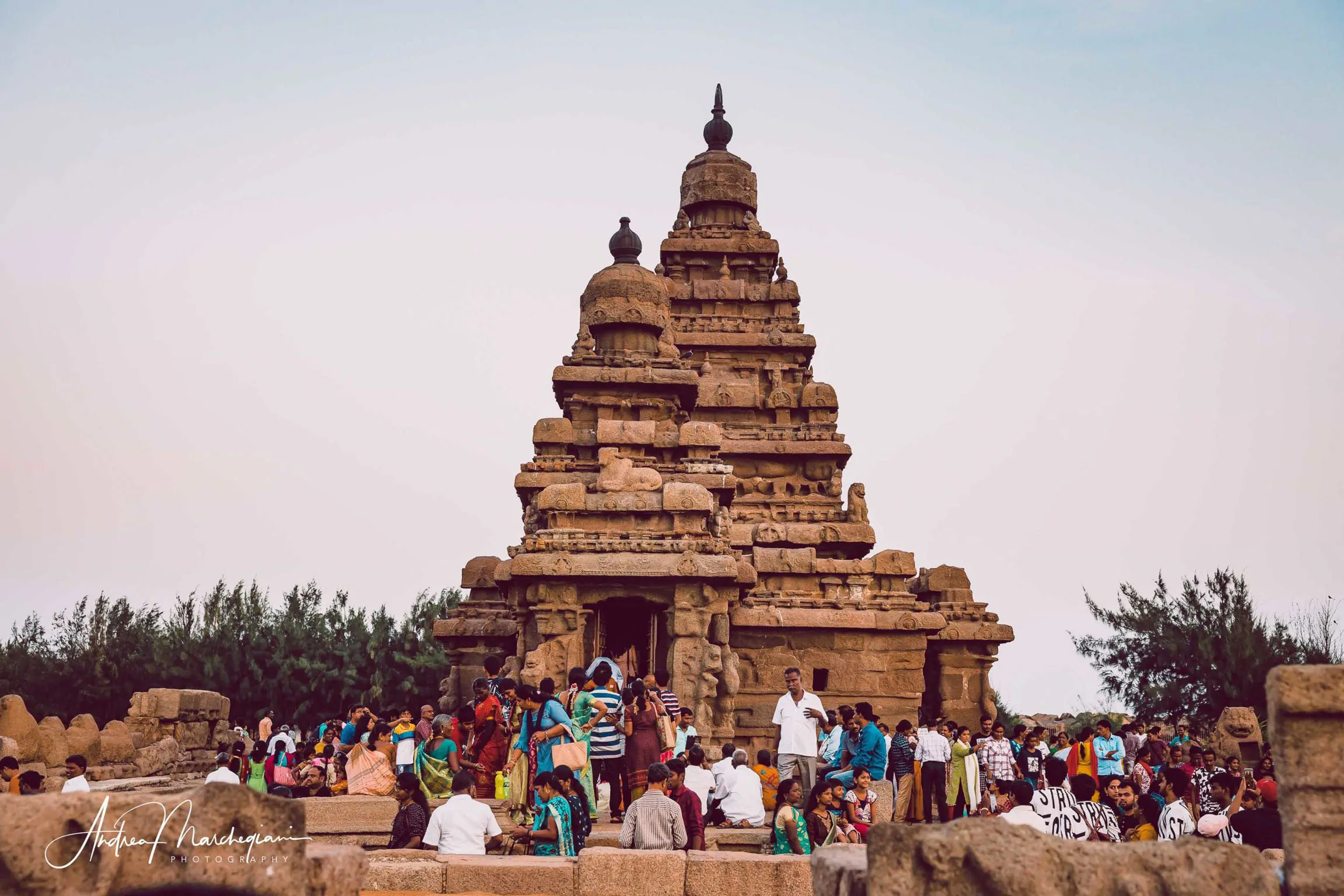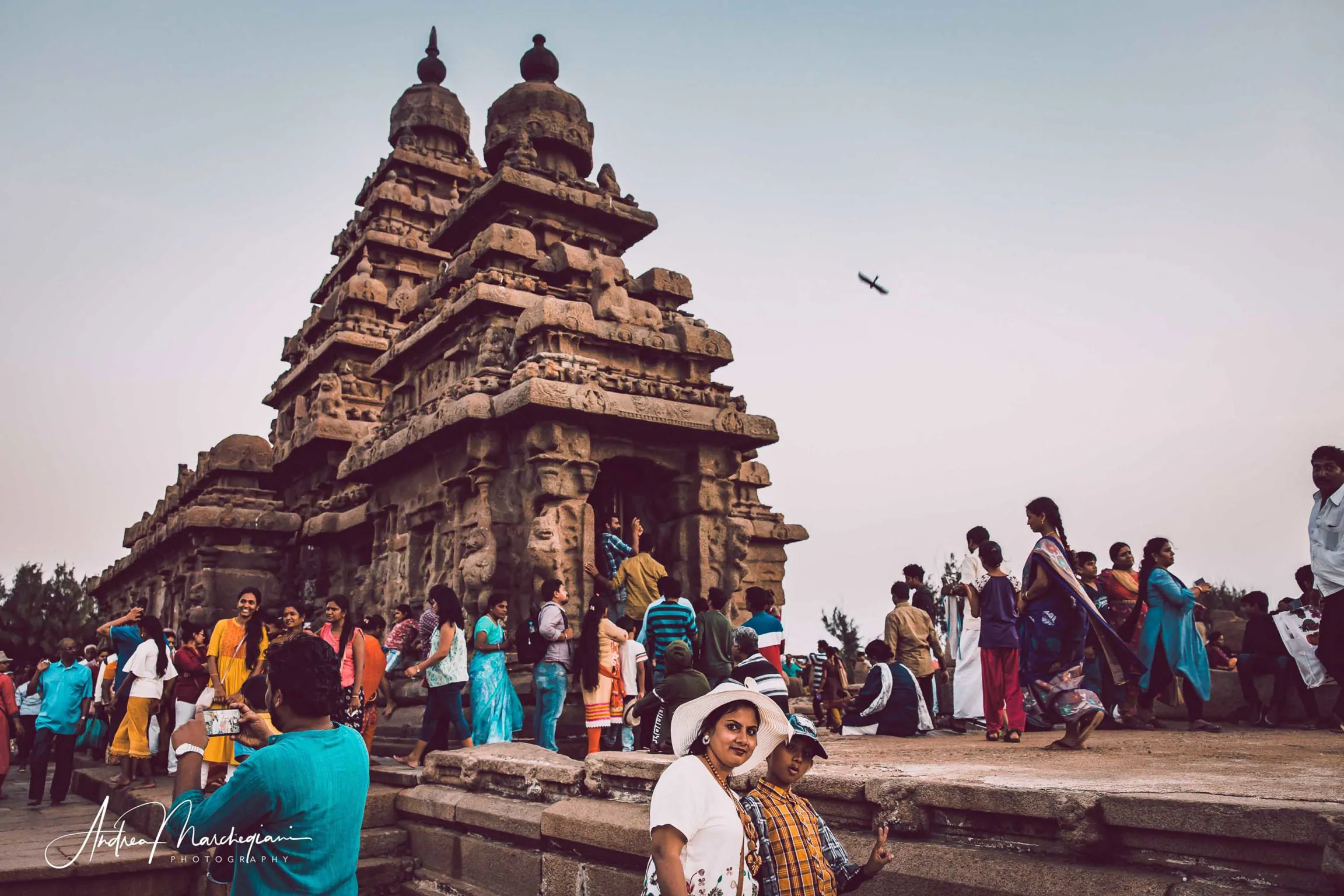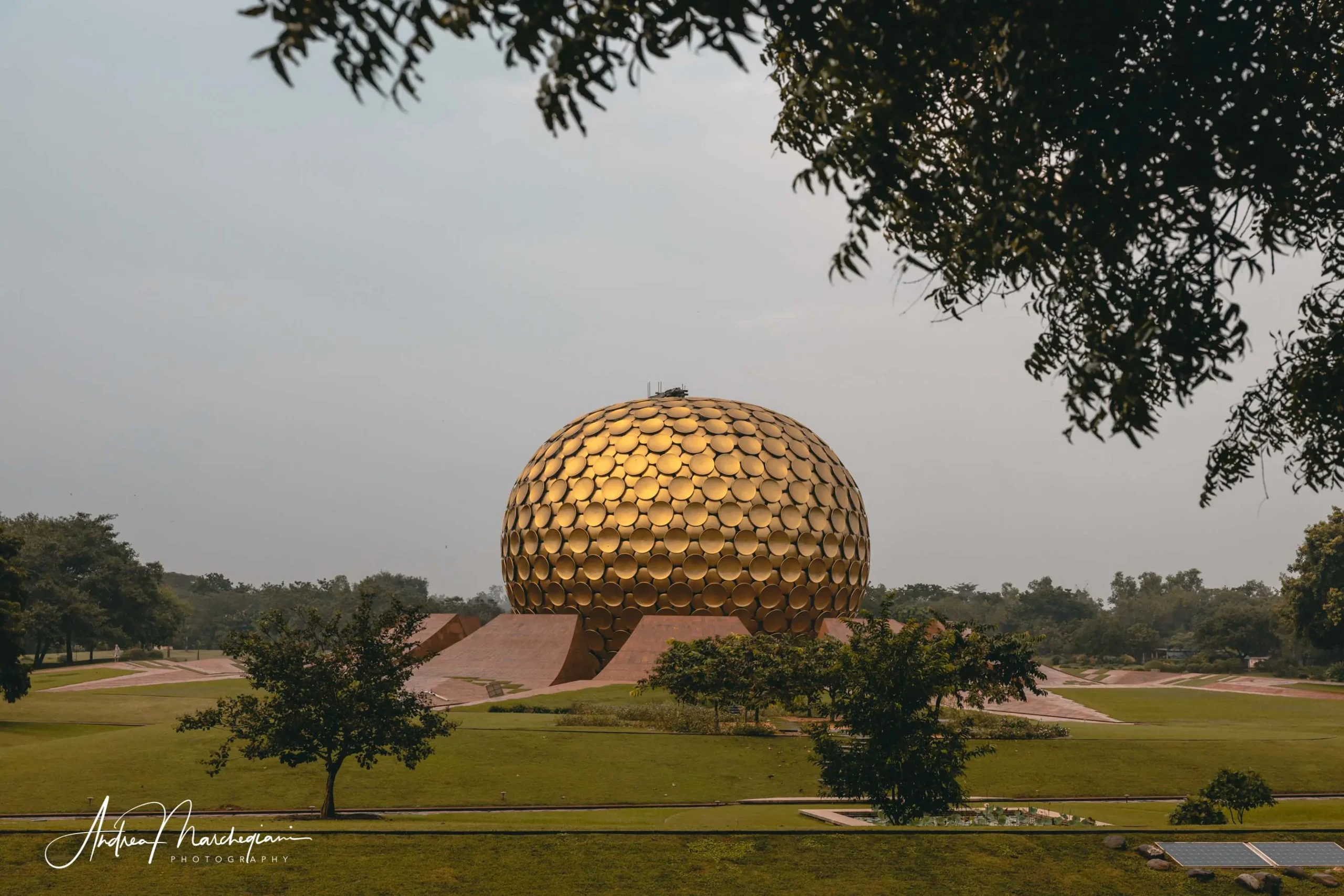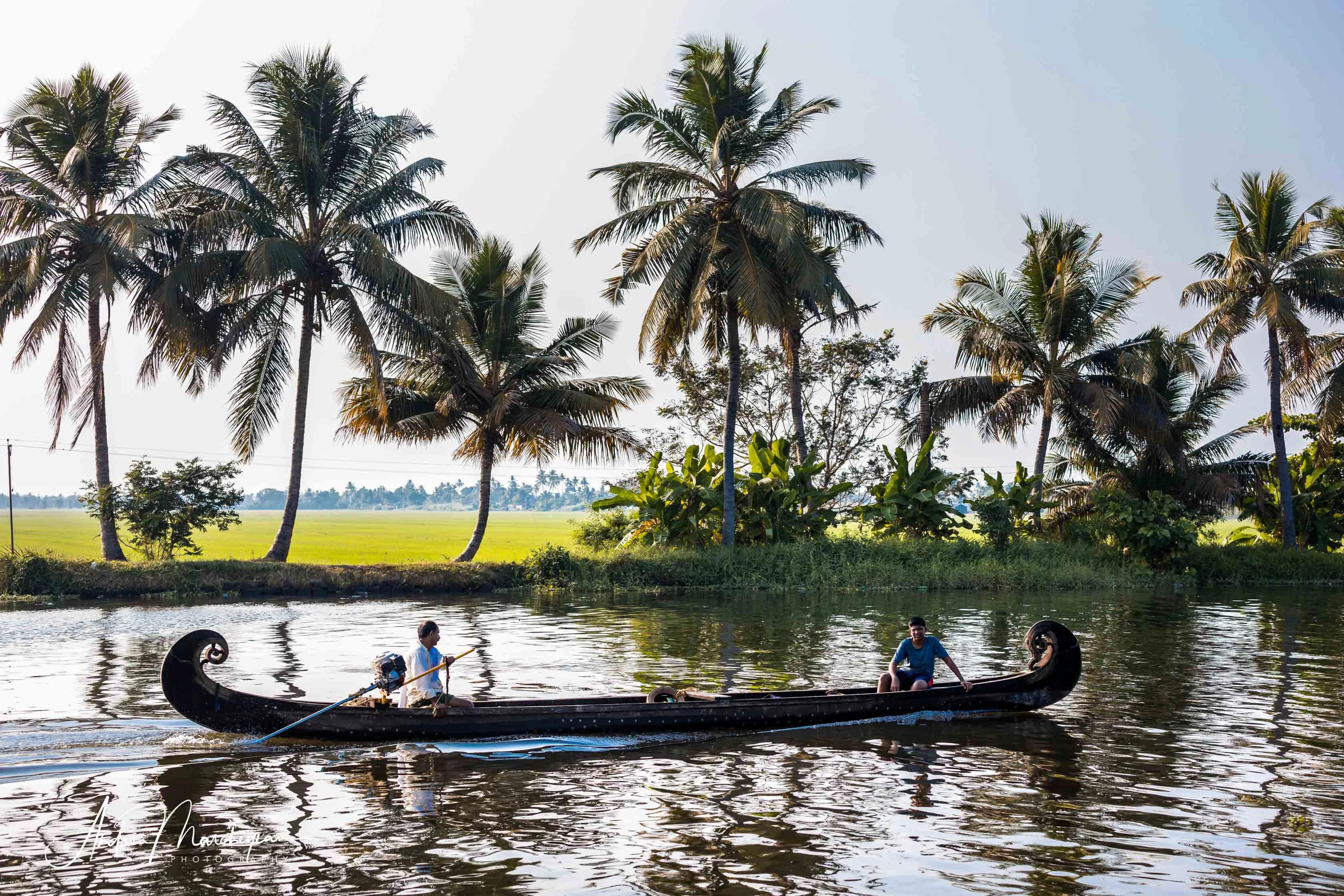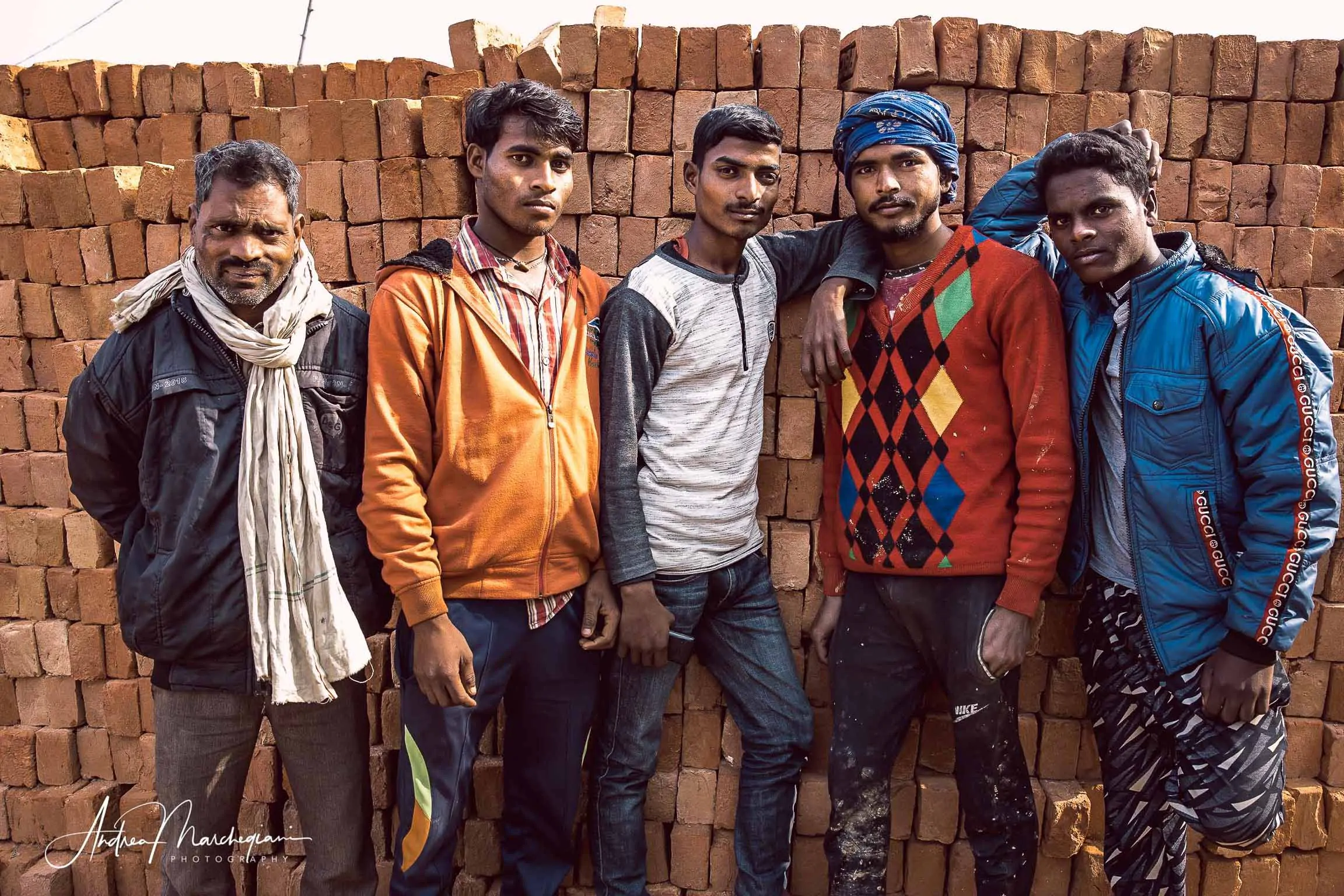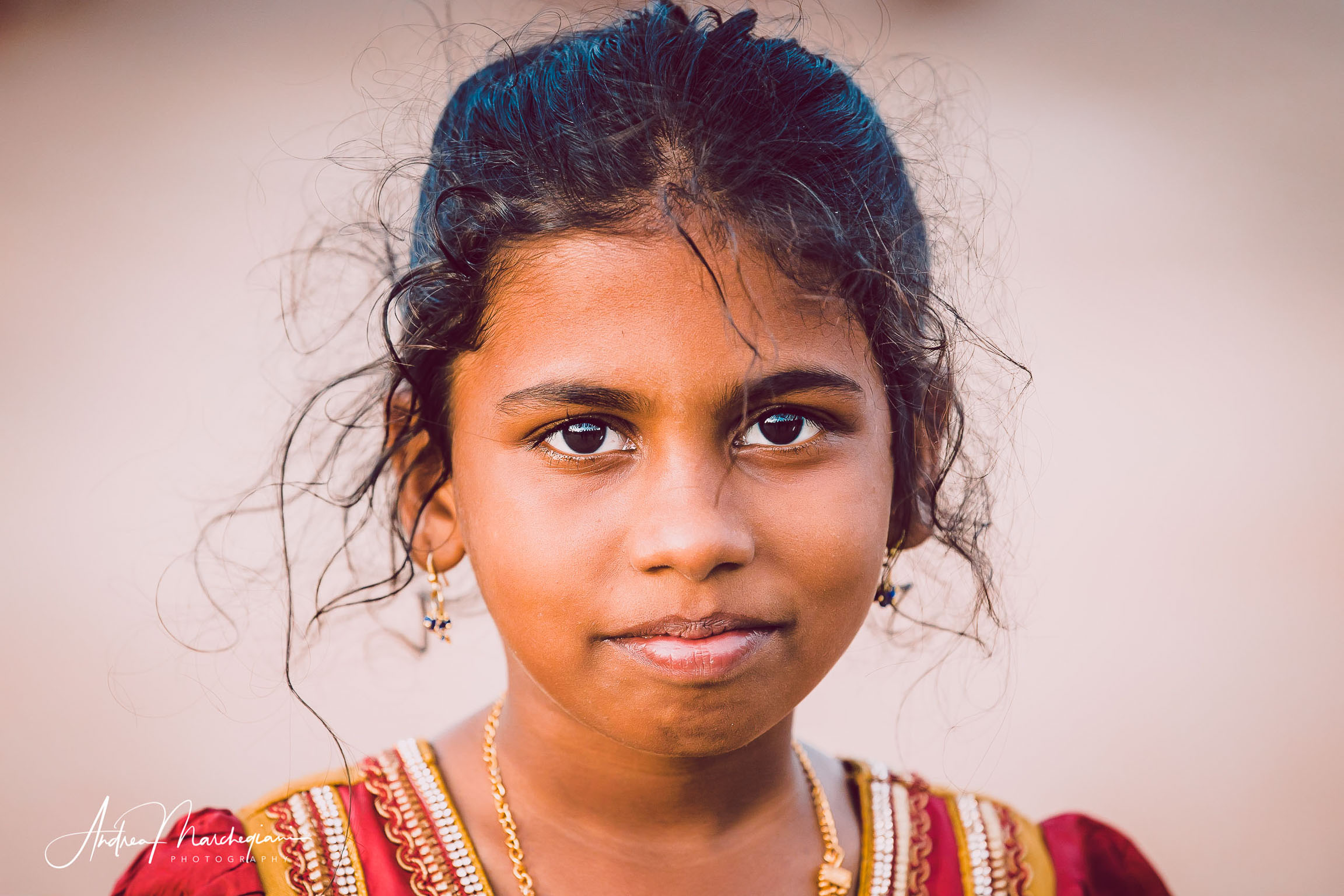
- Home
- Photo Galleries
- Portrait Photography
- Landscape Photography
- Street Photography
- China
- Ethiopia
- India
- Holy Ganges
- Varanasi
- Varanasi Ganga Aarti
- Varanasi, Manikarnika Ghat
- Varanasi Streets & Alleys
- Varanasi Demolition
- Varanasi Fruit Market
- Sarnath
- Brick Kilns
- Tamil Nadu, Chennai & Mamallapuram
- Tamil Nadu, Fort Tirumayam & Madurai
- Tamil Nadu, Tiruvannamalai & Thanjavur
- Kerala, Munnar
- Kerala, Peryiar
- Kerala, Backwaters
- Kerala, Kochi
- Kazakhstan
- Myanmar
- Senegal
- Uzbekistan
- Travel Blog
- China
- Ethiopia
- India
- Tamil Nadu & Kerala
- Varanasi
- Whato to do in Varanasi
- Varanasi Life along the Ghats
- Varanasi Death along the Ghats
- Varanasi Ganga Aarti Ceremony
- Varanasi demolished to honor Shiva
- Varanasi Fruit Market
- “Varanasi, A Journey into the Infinite”
- Sarnath
- All about River Ganges
- Holy Shit. All about Indian Cow Dung
- Clean India Project
- Brick factories
- Tilaka, pundra, bindi: what is the mark on Indian foreheads?
- Kazakhstan
- Mongolia
- Ulaanbaatar, the coldest capital in the world
- What to do in Ulaanbaatar
- Chinggis Khan Museum, 6 floors of Mongolian history
- Gorkhi-Terelj National Park and Bodgkhan Natural Reserve
- Altai Mountains, Things to do in Olgii and Sagsai
- Living with the Eagle Hunters
- Sagsai Eagle Festival
- Navrus Festival
- Xöömej, Mongolian throat singing
- Mongolian Food
- Myanmar
- Senegal
- Uzbekistan
- Latest Posts
- Photography Blog
- About
- Prints
Tamil Nadu is the quintessence of the Indian spirit. For over 2000 years, this region of southern India has developed its culture without influences from the north. Mamallapuram, the ancient port of the Pallava dynasty, with its temples dedicated to Shiva, fully embodies the Dravidian culture, mystical fervor and enthusiasm for life.
Share with your friends:
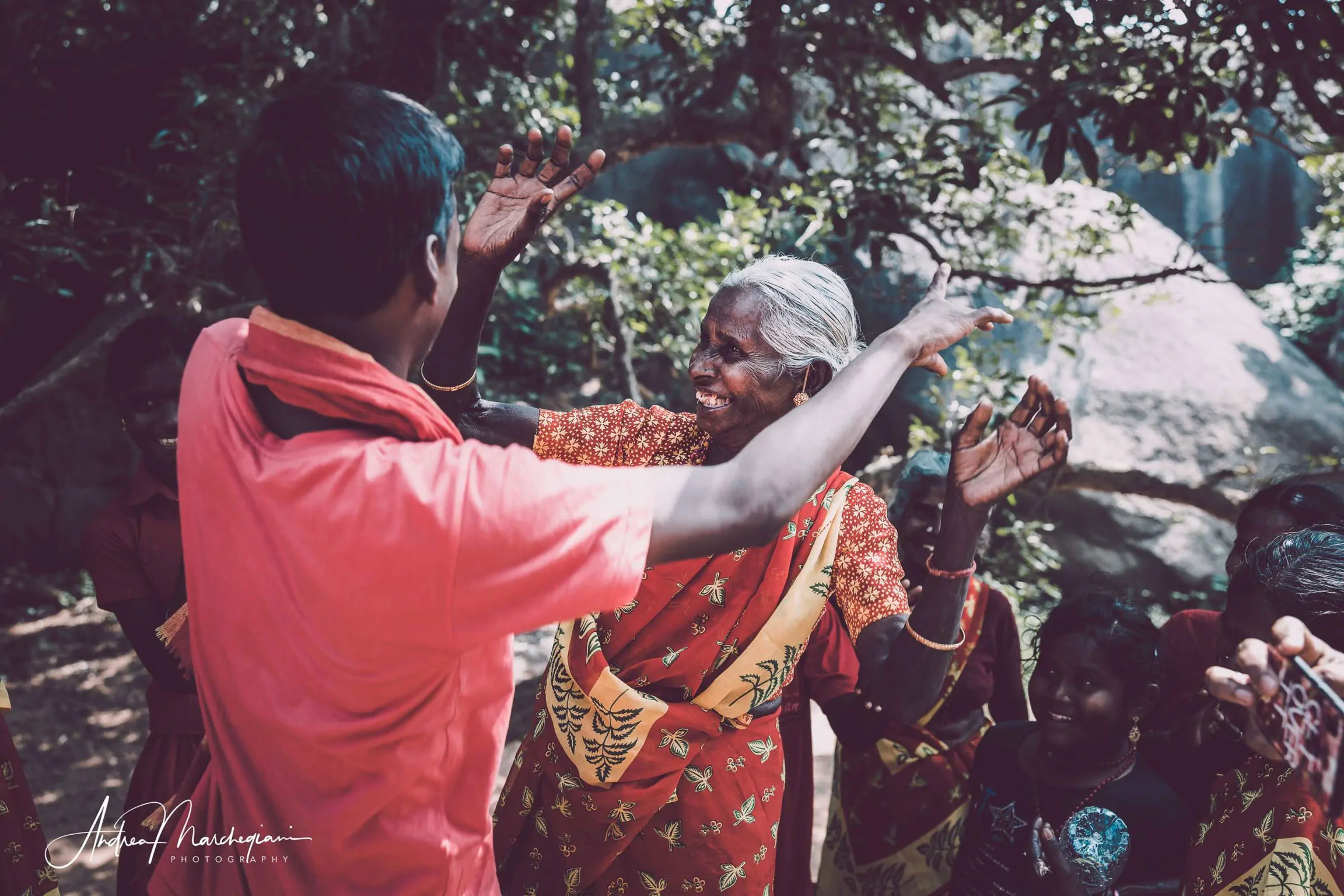
Mamallapuram Hill
My tour starts early in the morning, with a visit to Mamallapuram Hill. It is a rocky hill with a prehistoric appearance, full of historical monuments dating back to the seventh century. I am immediately struck by the large crowd of people waiting in front of the ticket office. My presence generates a lot of curiosity: it is my first encounter with the Dravidian people, who have lived in southern India for over 6000 years. They have dark, black complexion, smooth hair and bright, expressive eyes. As I’m about to discover, they have a friendly, sunny and joyful temperament!
I approach a group of ladies, queuing with children and grandchildren; they are wearing in beautiful brick-red saris. They wear jewelry, gold bracelets and eye-catching nose rings. Thick smooth, silvery hair contrasts with the complexion of the skin. “Can I take a picture of you?” I ask. They welcome me with lots of smiles, they take pictures of me and improvise a typical dance to welcome me!
How can you not love India?
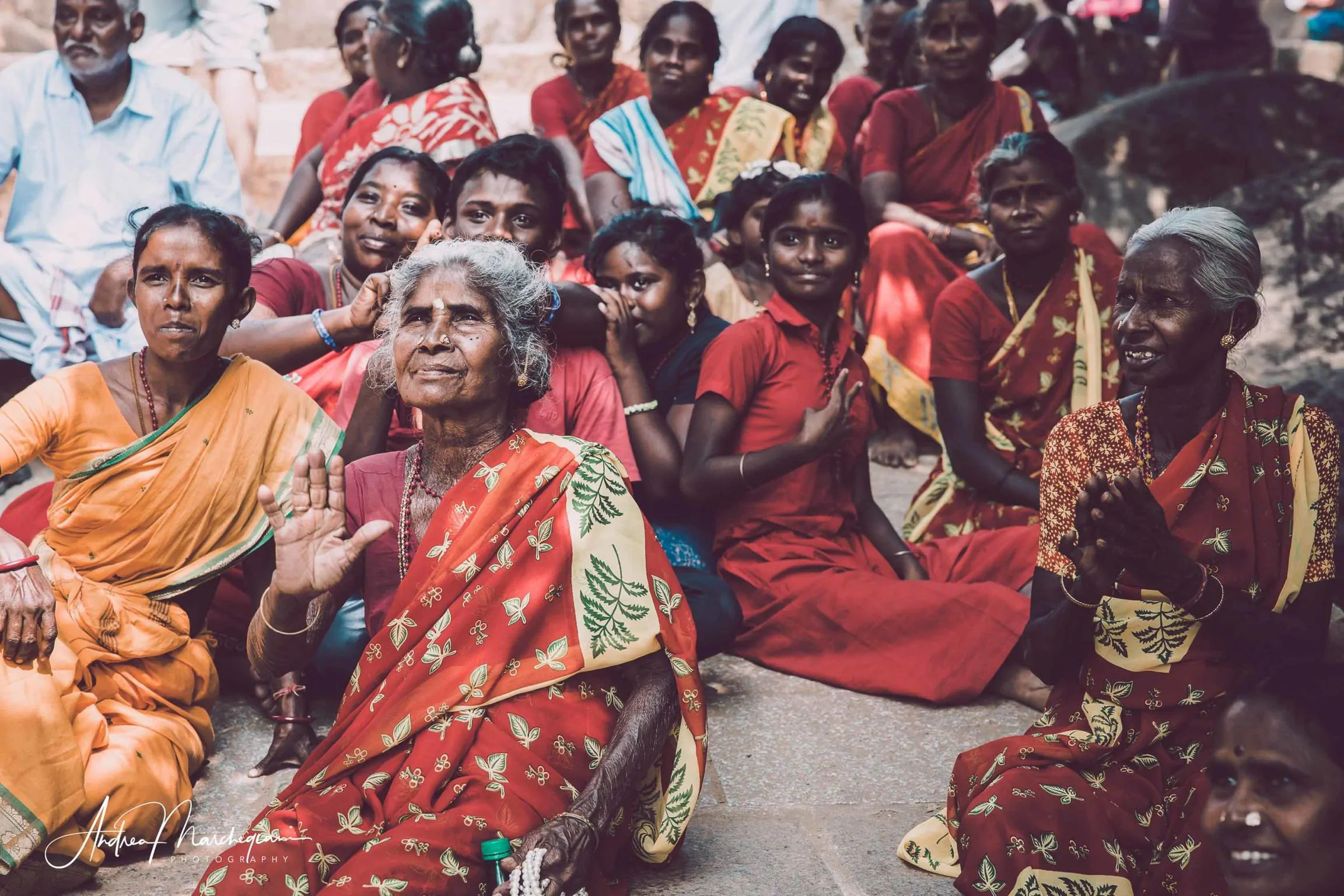
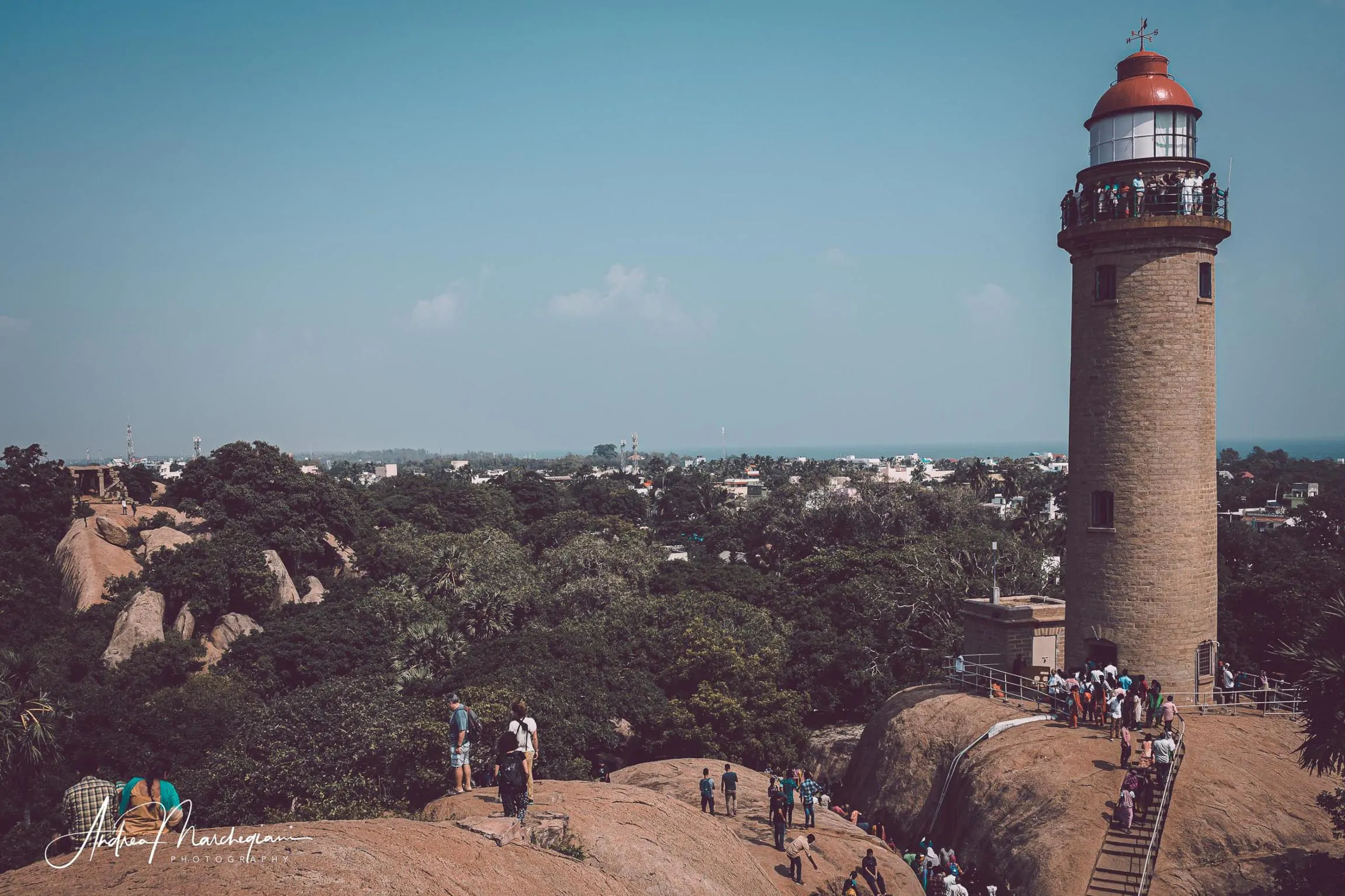
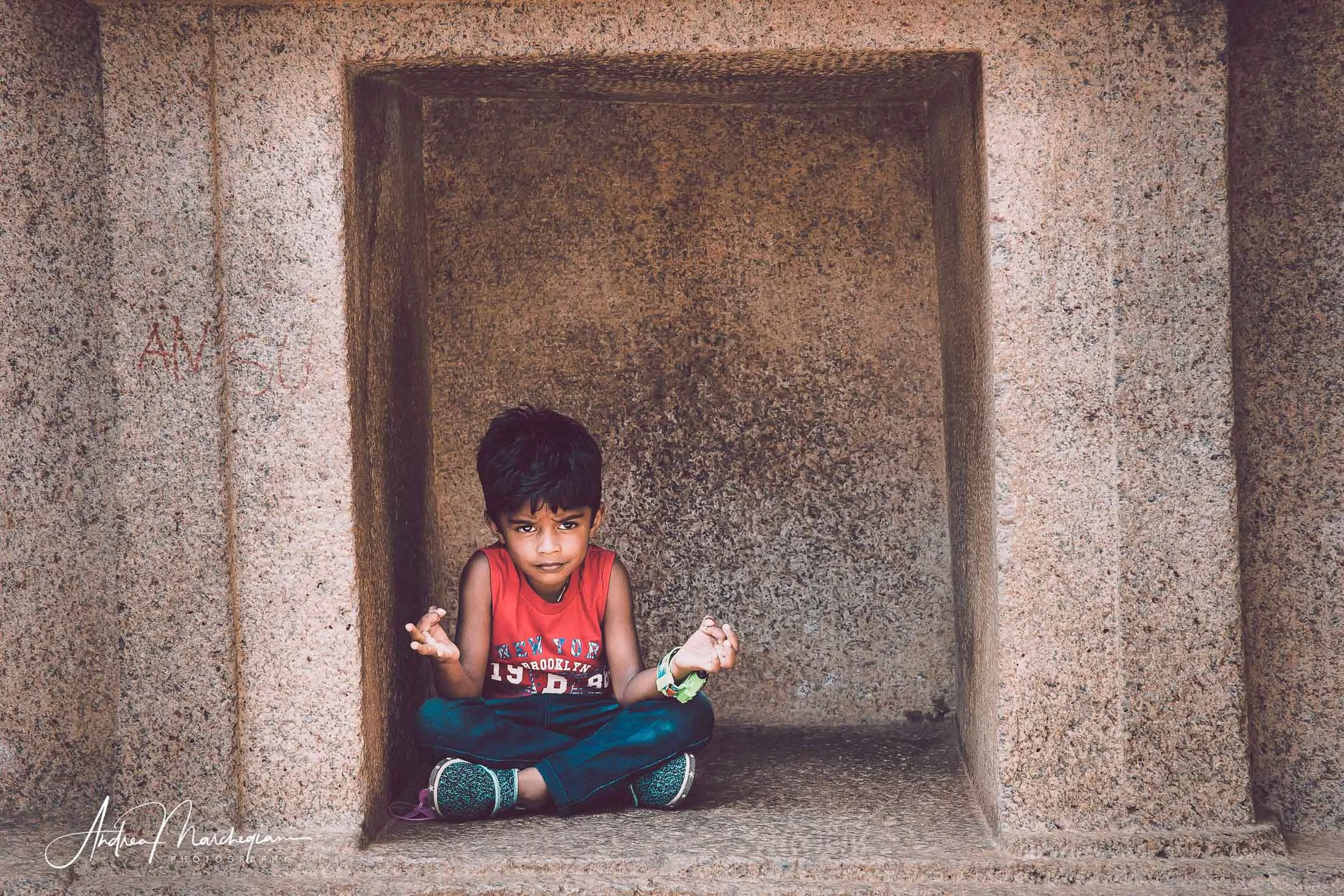
Near the entrance, I see Mammalapuram lighthouse, built in 1887 on top of a rocky promontory. Nearby are the remains of the ancient lighthouse built by the Pallava dynasty, which reigned from the third to the ninth century and built their main port in Mamallapuram. Unfortunately, the lighthouse has not been active since 2001, due to threats of attacks by local terrorist groups, but since 2011 it has been open to tourists.
A short distance away, on a twin spur, stands a temple dedicated to Shiva and carved into a single block of rock, the Mahishamardini mandapa. The line to visit it is orderly but kilometric. I adapt to the relaxed watys of Tamil Nadu and queue between the saris and turbans of other visitors.
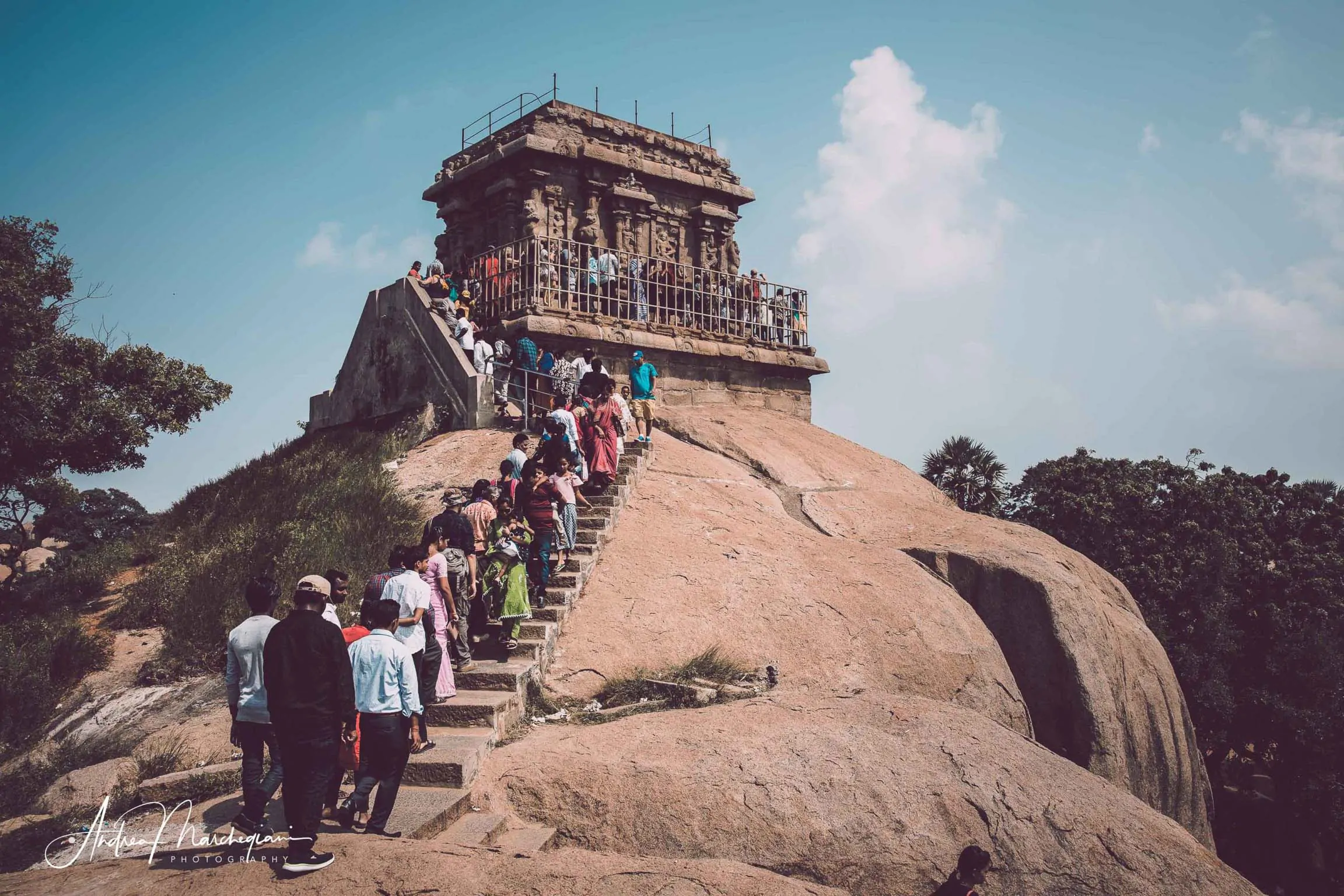
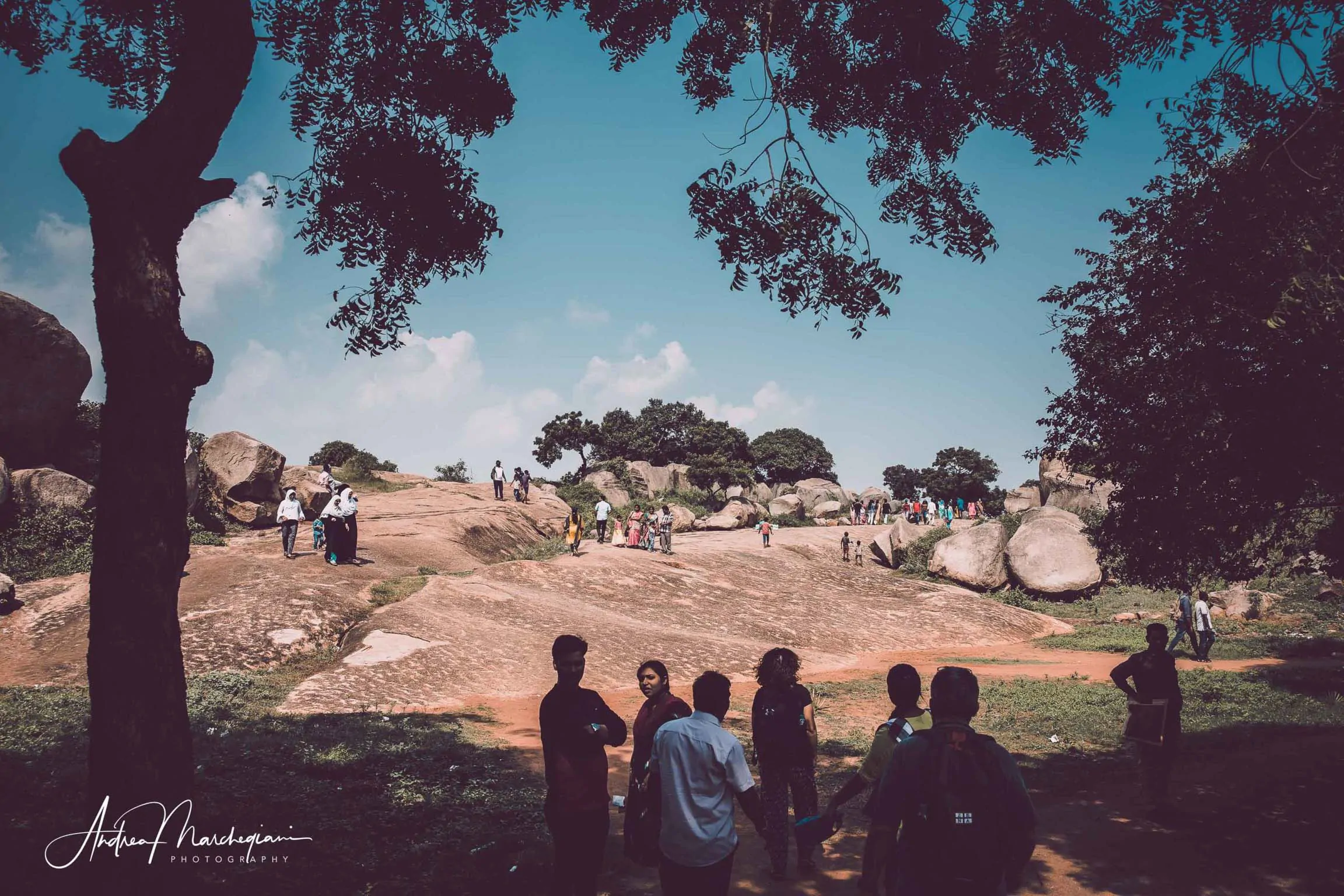
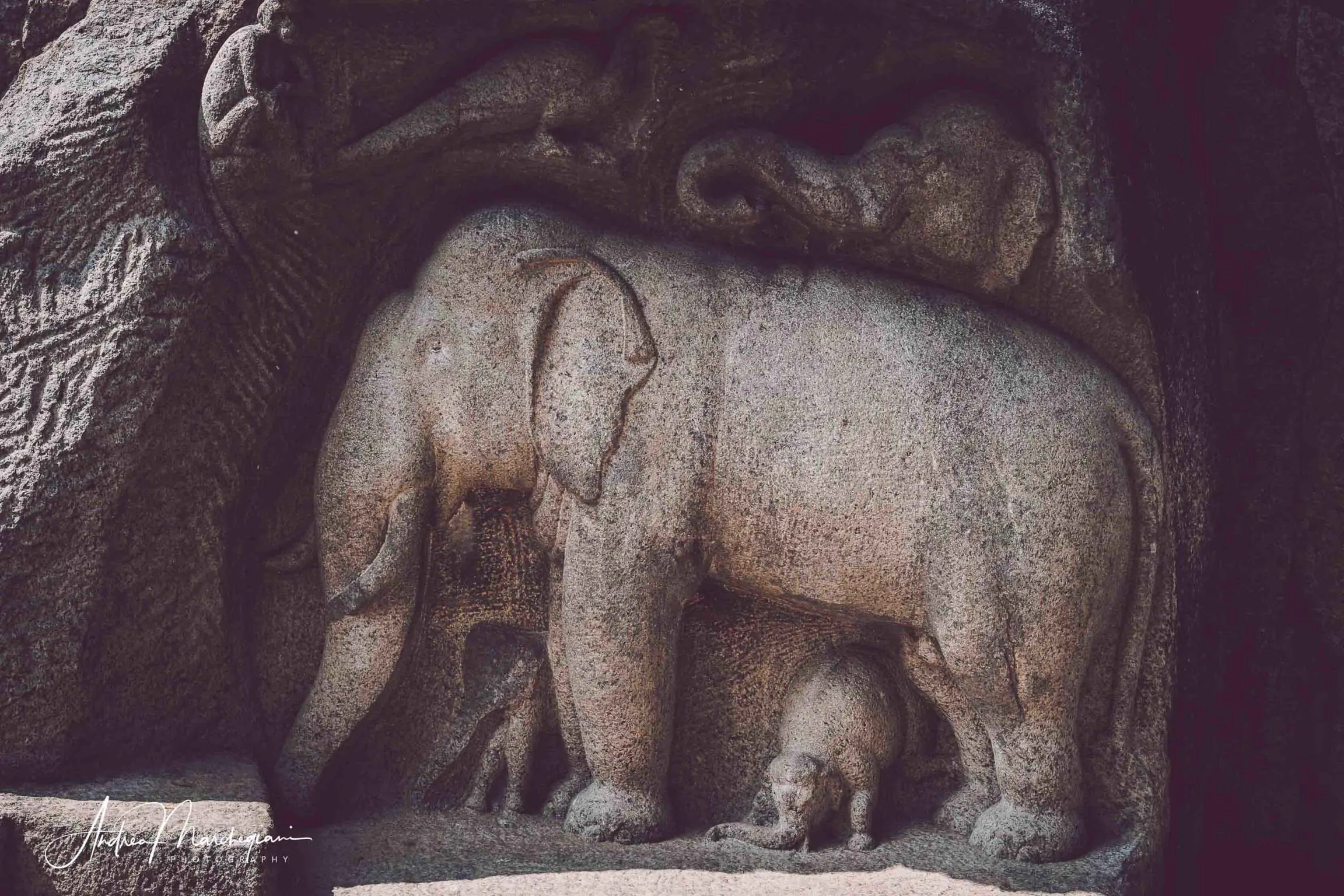
Krishna's butter ball
Walking north, among Shiva temples carved into the rock, columns depicting lions and large slabs on which groups of elephants are carved. Finally I come to the most famous site of the area, the so-called Krishna’s butterball.
It is a gigantic boulder, 6 meters high, 5 meters wide and 250 tons heavy. It hangs from a small slope and seems to be about to roll down, but it proved impossible to move! The Indians don’t know how to explain the balance of the rock, so their rich imagination has created a series of myths and very funny theories.
There are those who call it the “stone of the god of heaven” and claim it was the gods who placed it there, to show men their great power; there are those who claim the extraterrestrials brought it; finally, a local guide one day joked it was a little ball of butter that Kṛṣṇa accidentally dropped as a child. The god used to steal the butter, which he loved, from the bowl where his mother kept it. Since then, everyone has started calling it that.
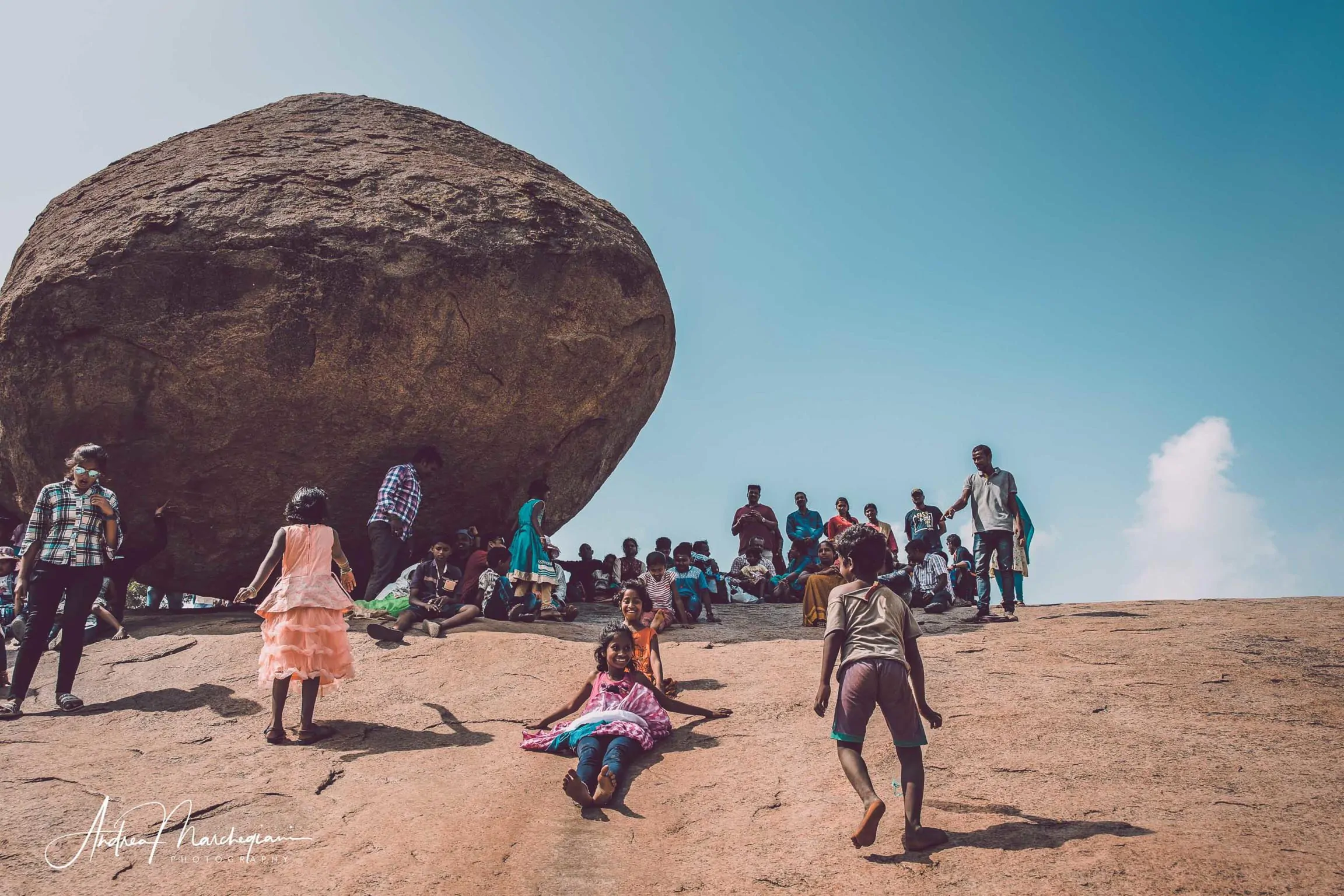
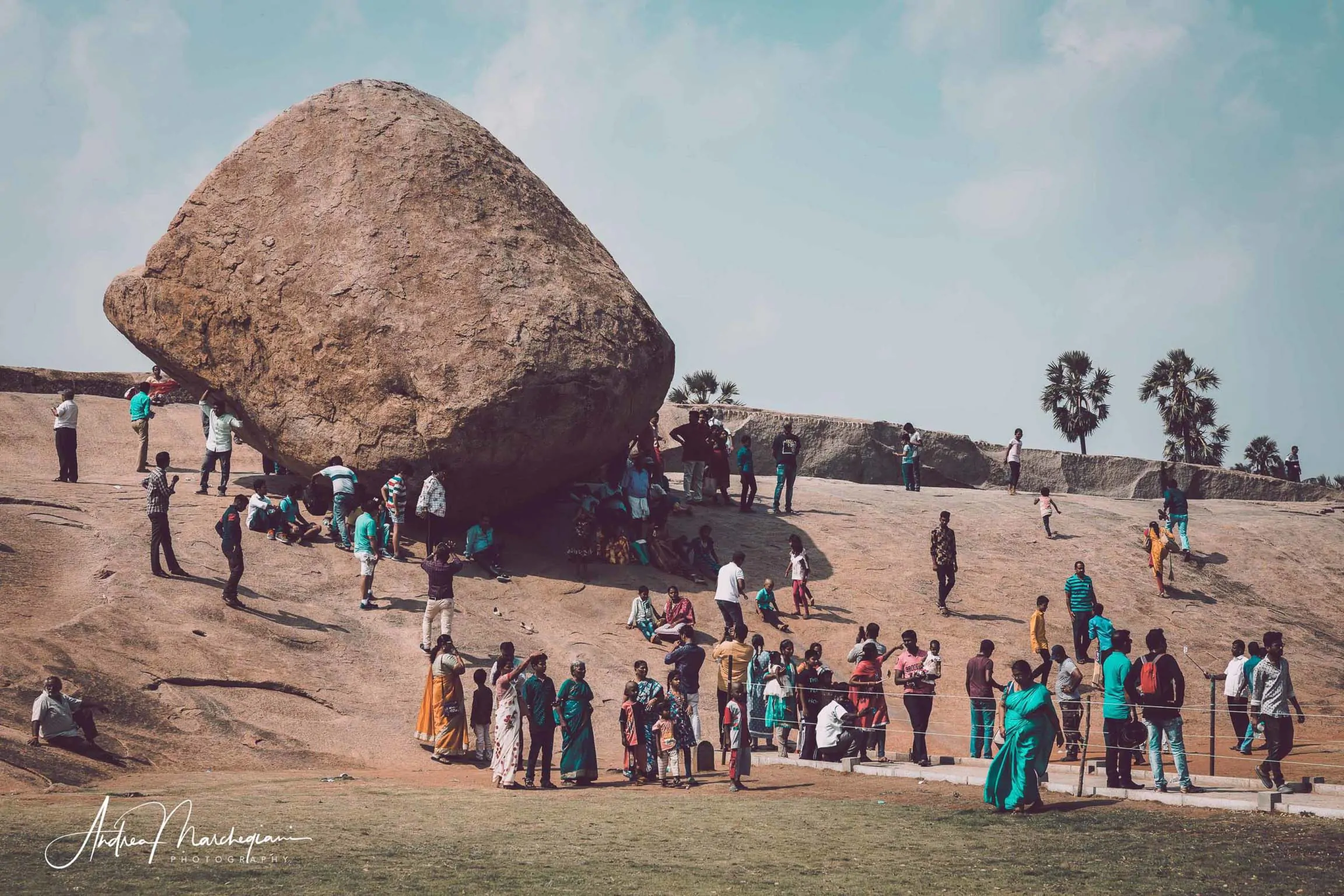
The fame of the boulder has increased over time, as two attempts to remove it failed: the first was in the seventh century AD, when King Pasolini Narasimhavarman wanted to move it to save it from the sculptors of the area; the second happened in 1908, when the governor of Chennai (at the time Madras) tried to remove it to save the city from a possible collapse. He brought an army of men and elephants to drag him downstream, but the boulder wouldn’t move an inch. Today the stone is the main attraction of Mamallapuram Hill.
It recalls the Burmese site of Golden Rock, with the Buddhist altar built on a rock in precarious balance. This also seems to defy the laws of physics and in fact inspired the legend that a hair of Buddha, placed below the rock, would prevent it from rolling downstream. But the climate around the site could not be more different: there is nothing like the mysticism of Burmese Buddhist prayers here, but groups of rowdy children who use the descent to the side of the boulder as if it were a slide!
India is one of the youngest and most prolific countries in the world. Do not go there if you do not want to feel old, do not go there if you do not love the noise and laughter of children’s mischief.
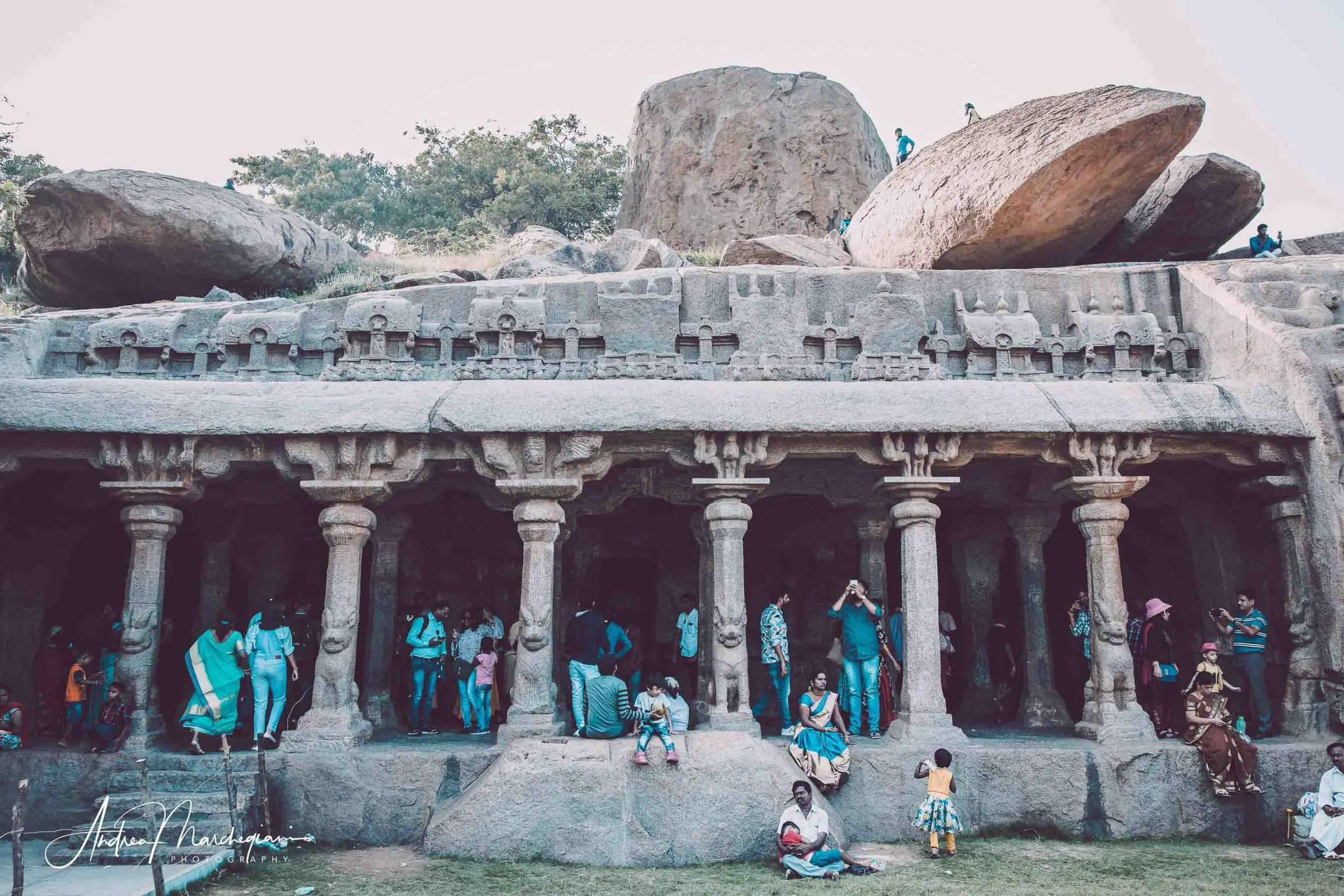
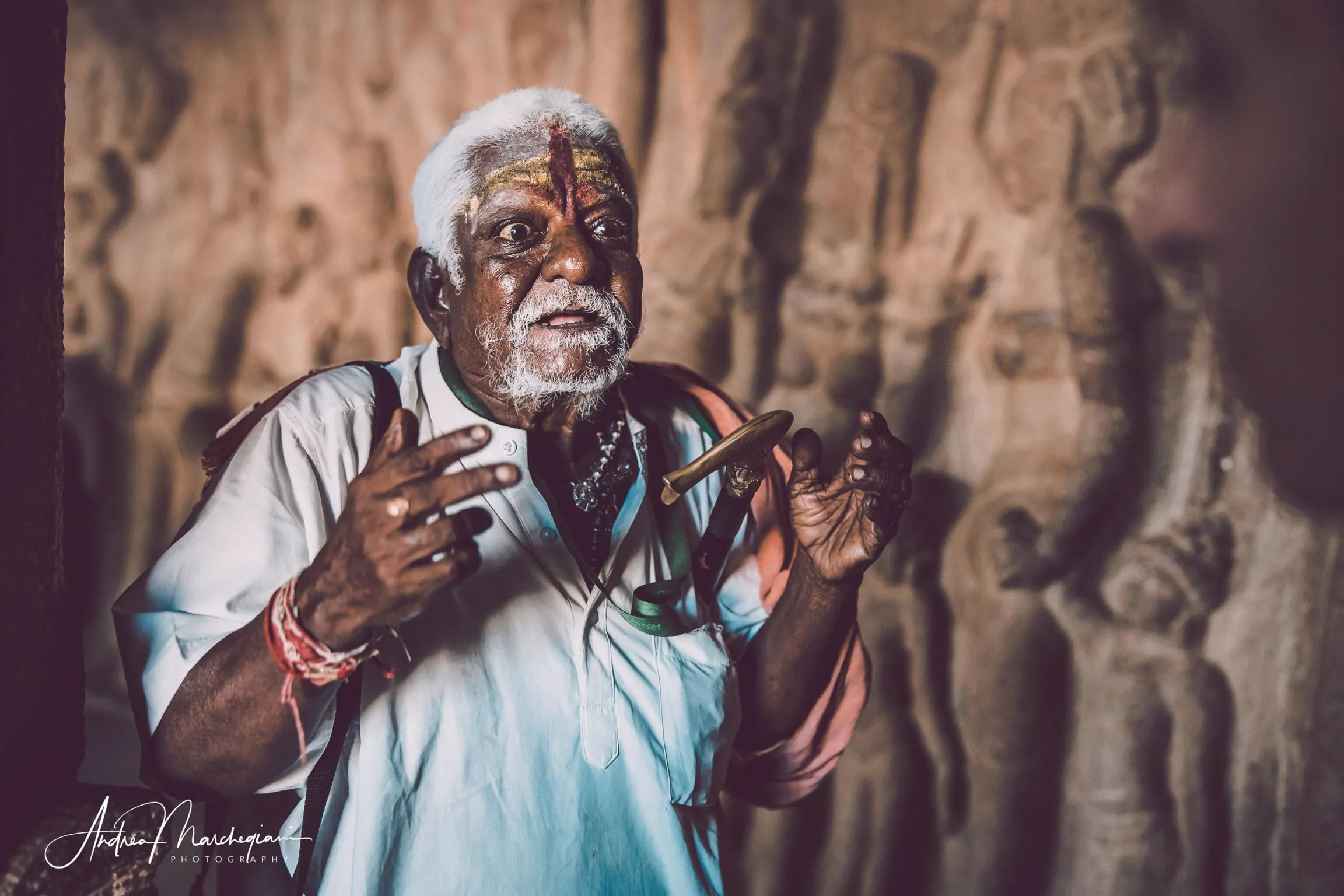
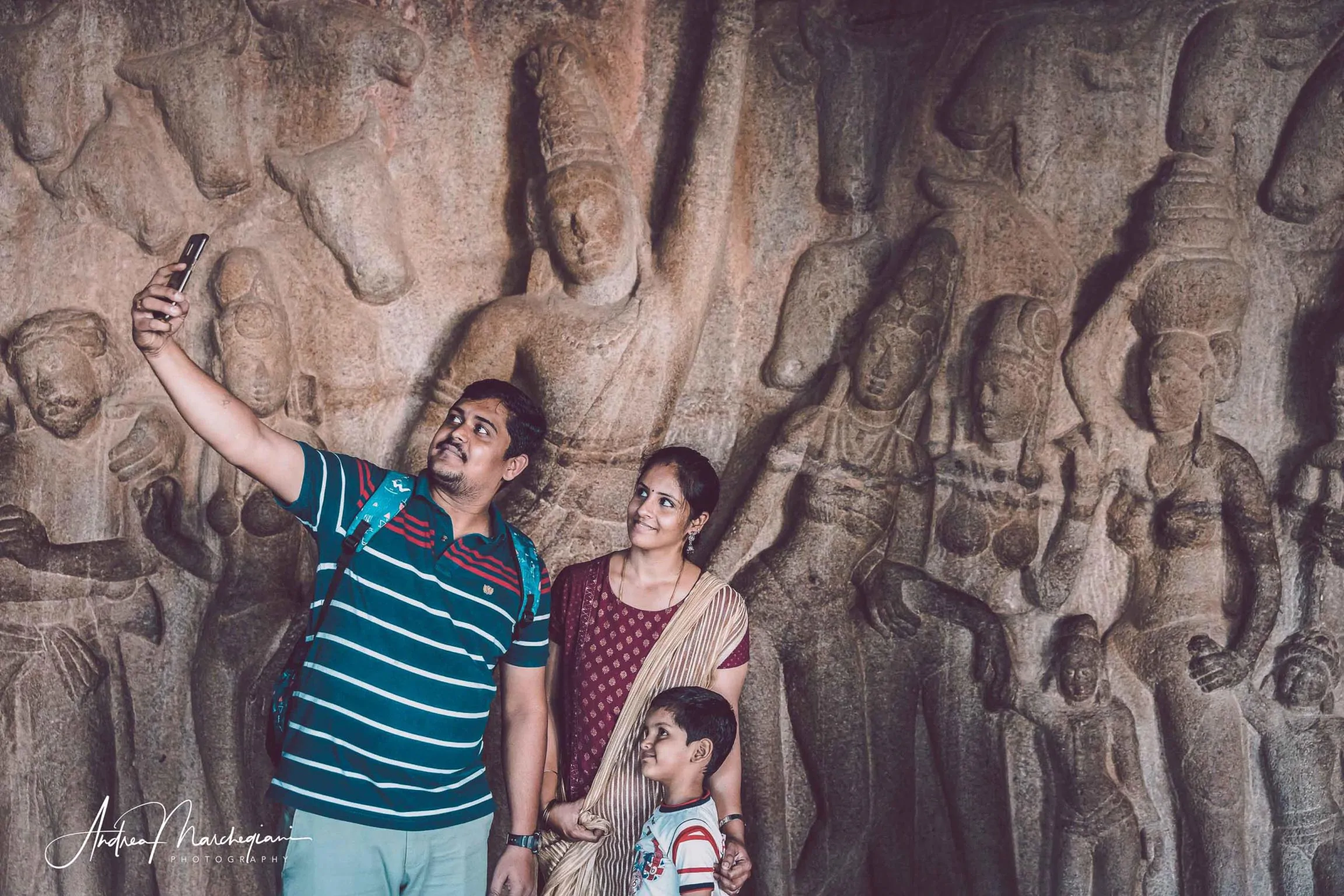
Varaha Cave Temple
An old man, walking with an elegant wooden stick, approaches me and shows off his best smile. “You cannot understand the value of the Varaha Cave Temple without me as your guide,” he solemnly tells me. “I speak excellent English and I know all about his story,” he assures me in barely comprehensible English.
More to enjoy his company and his ancient look than for the confidence in his guide skills, I decide to hire him. “It will take at least an hour,” he announces with the same solemnity. “But I have no more than half an hour!” I answer.
“Half an hour is more than enough time!” he replies.
I see where this is going…
The old man explains this is a temple dug into the rock and dedicated to one of the avatars of Visnu. He extends his endless explanations on the various degrees of kinship between the gods, then illustrates the stories depicted on the bas-reliefs and evokes completely meaningless anecdotes.
Hinduism, with its thousand gods and endless epic tales, escapes my understanding. I will have to visit many other temples and listen to these anecdotes many more times before overcoming this feeling of disorientation. As I nod to my fascinating guide, I am bewitched by the hypnotic eyes of this cute old man.
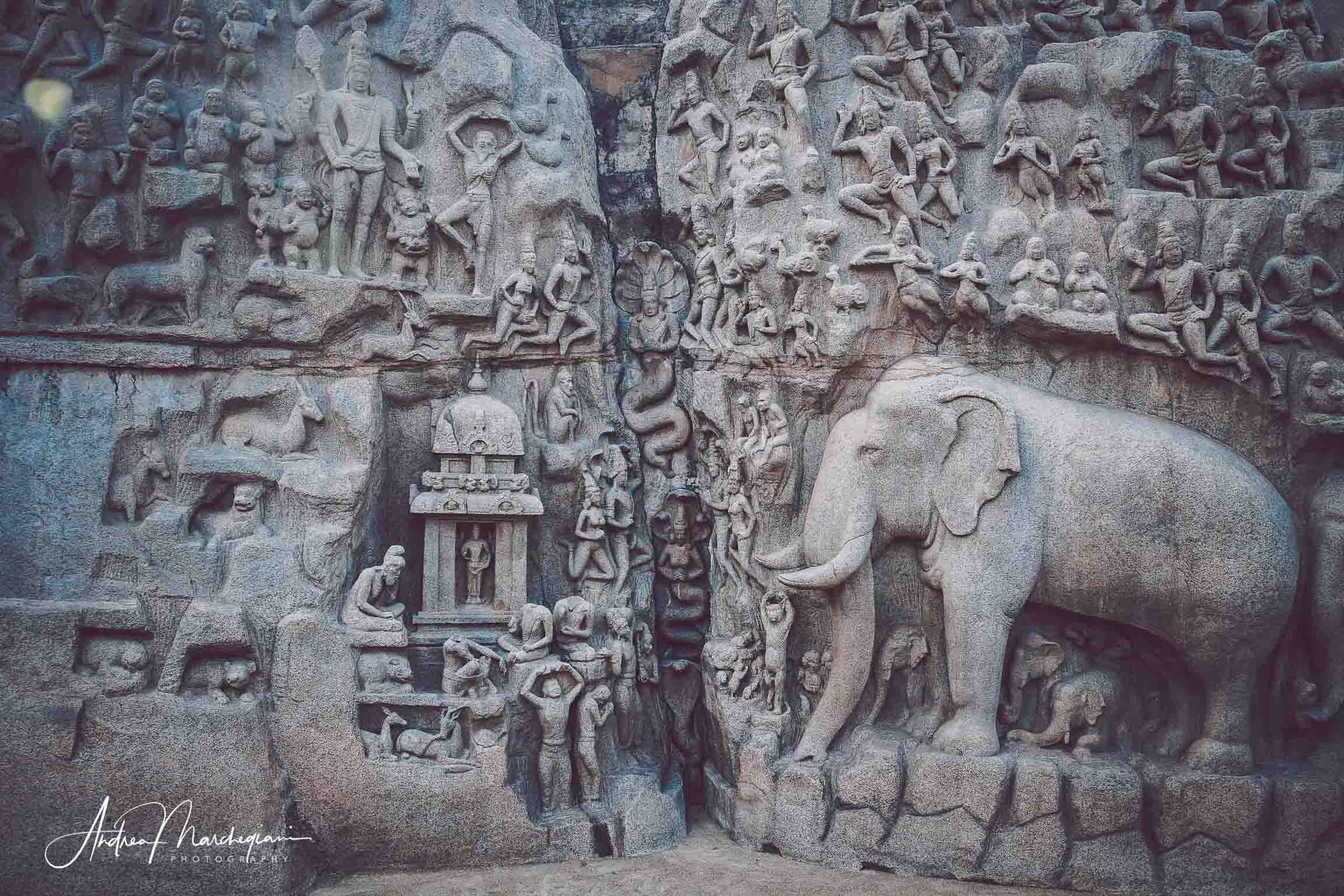
Arjuna's Penance
A few meters away, there is the wonderful Arjuna’s Penance, or Descent of the Ganges. It is impossible not to be impressed by the size of these two large stone slabs, which are one of the most important ancient works of art in India. Again, the Indian imagination allows the work to have two different interpretations, both valid.
According to the first, the bas-relief represents the descent on earth of the Goddess of the river Ganges, made possible by the penance of the wise Bagiratha, who meditates; in the second version, instead, the figures represent the fasting of the hero Arjuna to get the gift of an invincible weapon from Shiva. In a corner of the work, you can see a cat imitating the penance of the hero/sage in front of an audience of mice. A pinch of humor never hurts.
I greet the old talker who lent himself to be my guide and take one last photo. He too is a work of art in my eyes.
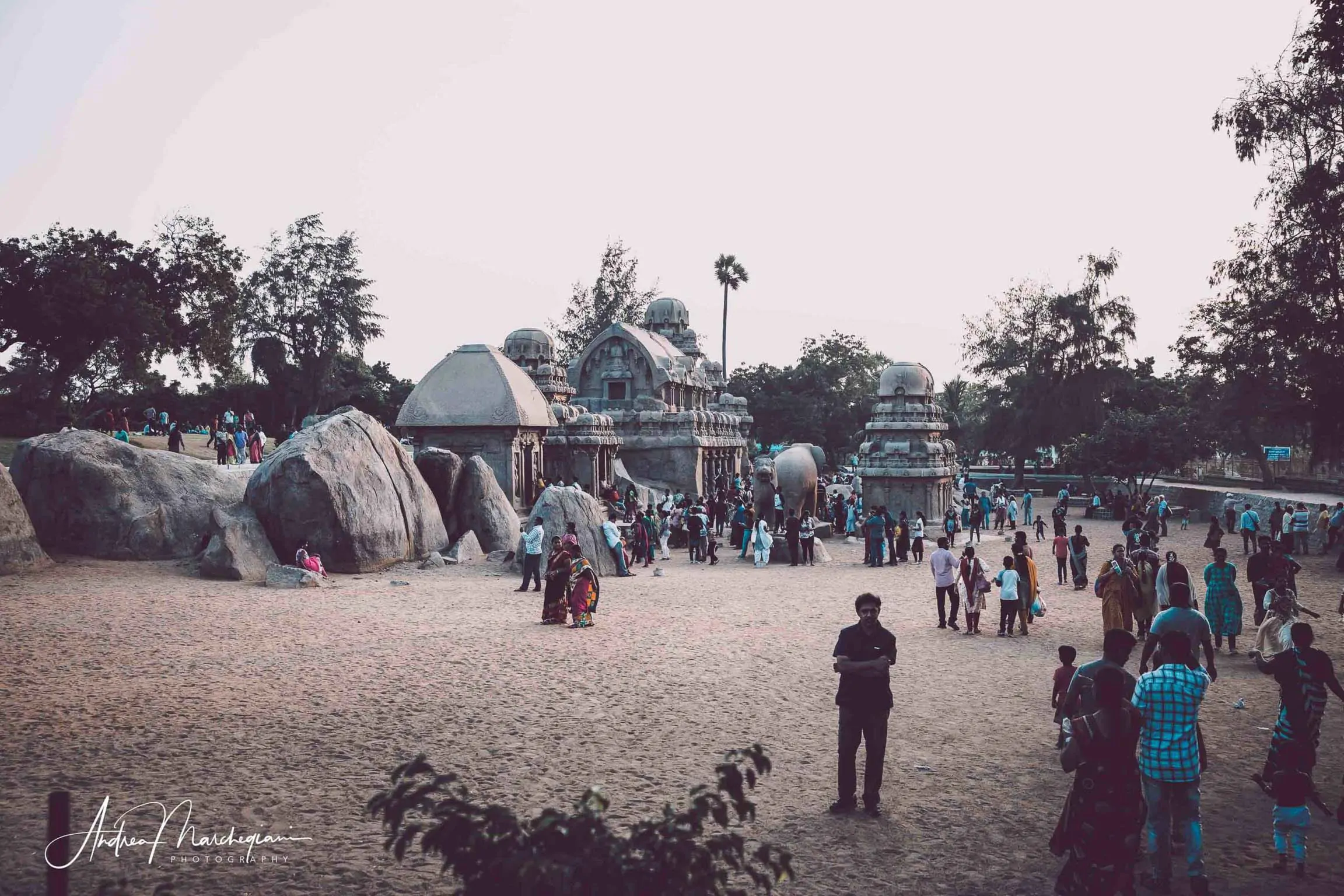
Five Rathas (Pancha Rathas)
It’s late afternoon, the best time to visit the Five Rathas and the Shore Temple. The Rathas are 5 temples carved into the rock, buried under the sand for centuries and unearthed by the British in the nineteenth century.
Each temple is dedicated to one of the Pandava brothers, heroes of an ancient epic poem, and to their common bride Draupadi. Perhaps these temples, very small in size, were models for structures to be built elsewhere.
Around the 5 temples, the crowd of visitors makes it almost impossible to take a picture. I immediately lose hope of doing so by excluding people. And here comes the far-fetched! Instead of stepping back to let me take pictures at temples, whole families gather in front of the camera, posing for me as if it was obviously them I was trying to photograph!
The parents, proud of their beautiful children, ask me to photograph them and when they notice their grandfather or aunt who did not enter the picture, they squeeze tighter and ask me to repeat the shot! Then we exchange instagram contacts with the promise to send us photos.
Again, how can you not love India?
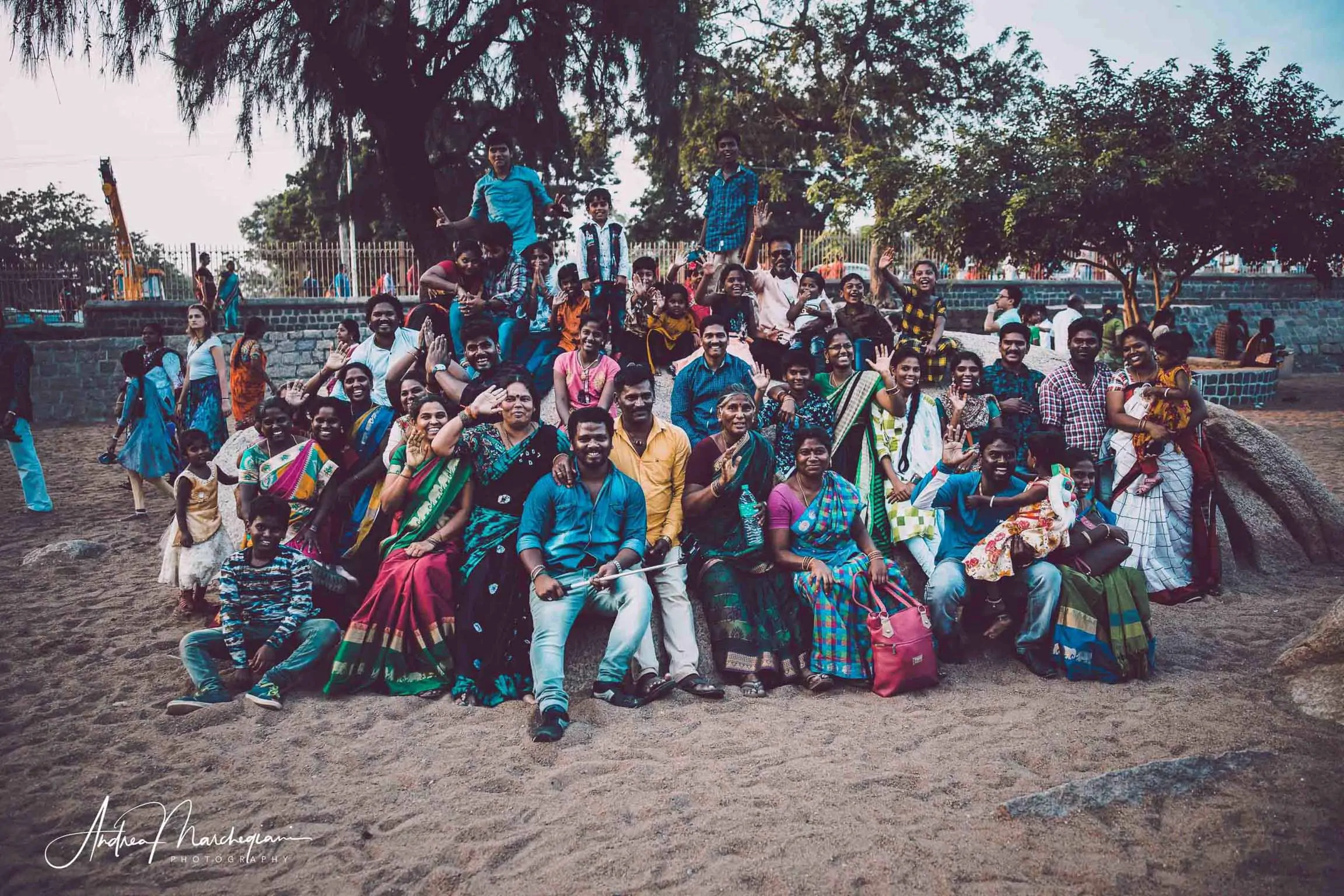
The Shore Temple
The sun is melting in the ocean as I arrive at the last leg of my tour, the Shore Temple. The watchman starts asking tourists to leave the site, to close it. I have a few minutes and I try to make the most of them.
The Shore Temple is located within the Bay of Bengal and is the first temple not carved into the rock of all Tamil Nadu. Erected in granite boulders, it has sculptures and towers of excellent workmanship, but they seem to have dissolved over time.
“The temple dates back to the 8th century,” explains my driver Pandiyan. “It was part of a larger complex that has been submerged for centuries. The 2004 tsunami also hit this area. It partially damaged the temple but also brought back the remains of the surrounding buildings”.
It’s time to leave, the site is about to close. With my head dazed by the heat and the many smiles I received, I return to the hotel with the feeling that Tamil Nadu is pure distillate of vitality and sun.
PS: Visiting Mamallapuram in December-January not only allows you to enjoy a not too torrid heat, but also to attend the Indian Dance Festival.
